CHESSBOOK REVIEWS

Latest book
reviews of 1 January 2021
Wilhelminalaan 33
7261 BP RUURLO
The Netherlands.
John
Elburg
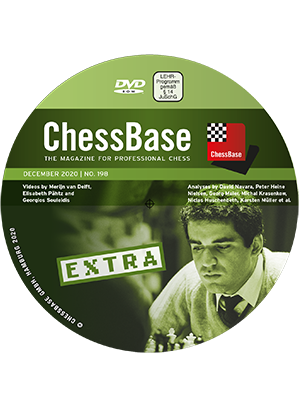
ChessBase Magazine issue 198
Extra
December 2020
ChessBase
http://www.chessbase.com
E-Mail
info@chessbase.com
ISSN 1432-8992
Euro 12,99
System requirements:
Minimum: Pentium III 1 GHz, 1 GB RAM, Windows Vista, XP
(Service Pack 3), DirectX9 graphic card with 256 MB RAM, DVD-ROM drive,
Windows Media Player 9, ChessBase 12/Fritz 13 or included Reader and
internet connection for program activation. Recommended: PC Intel Core
i7, 2.8 GHz, 4 GB RAM, Windows 8.1 or Windows 10, DirectX10 graphic
card (or compatible) with 512 MB RAM or better, 10
ChessBase 198 Extra comes with over one hour video entertainment from
players as Merijn van Delft on the good old Keres Attack, Elisabeth
Pähtz continues her video analysis of the Awerbach System (1.d4
Nf6 2.c4 g6 3.Nc3 Bg7 4.e4 d6 and Georgios Souleidis is good for a fine
analyse between two brilliant minds.
The main file of this DVD of download is good for over 40000 entries,
all played between Budapest 3/10 and Skalica Rapid 29/8.
Highly recommend to is the Lucky bag where I found 29 heavily analysed
games as the following one from the great Hikaru Nakamura.
Aronian,Levon (2773) - Nakamura,Hikaru (2736) [E47]
Saint Louis Rapid Lichess.org INT (7.4), 17.09.2020
[Krasenkow,Michal]
1.d4 Nf6 2.c4 e6 3.Nc3 Bb4 4.e3 0-0 5.Bd3 c5 6.Nge2 d5 7.cxd5 cxd4
8.exd4 Nxd5 A typical position with the isolated central pawn. White's
e2 knight is not so active, though, so Black should not have serious
problems. 9.Qc2 h6 10.0-0 Nc6 11.Rd1 Bd6 The most precise move,
according to the theory. 12.Bh7+ A typical check (Black's king is
placed worse on h8 than on g8) but it doesn't bring White any real
benefit. [The immediate 12.Be4 is harmless, too: 12...Nce7 13.Qb3 b6
(13...Nf6 14.Bf3 a6 15.Bf4 Bxf4 16.Nxf4 Qd6 17.Nh5 Nxh5 18.Bxh5 Bd7
19.Qxb7 Rab8 20.Qa7 Rxb2 21.Ne4 Nc8 22.Nxd6 Nxa7= 1/2 (37) Gelfand,B
(2723)-Topalov,V (2801) Monte Carlo 2006) 14.Bxd5 Nxd5 (14...exd5
15.Bf4 Bg4 16.f3 Be6 17.Rac1 a6 18.Na4 Rb8 19.Qd3 Ra8 20.Bxd6 Qxd6
21.Qa3!? Rfd8 22.Qxd6 Rxd6 23.Rc7² 1-0 (36) Lerner,K
(2530)-Makarov,M (2510) Helsinki 1992 CBM 032 [Ftacnik,L]) 15.Nxd5 exd5
16.Bf4 Bg4 (16...Ba6!?=) 17.f3 Be6 18.Rac1 Re8 19.Re1 Bf8 20.Bc7 Qd7
21.Be5 Rac8= 1/2 (25) Boros,D (2499)-Zhigalko,S (2656) Warsaw 2010;
12.a3 Nce7 a) 12...Bd7 13.Nxd5 exd5 14.Bf4 Bg4 15.Bxd6 Qxd6 16.Qc5 Qf6
17.h3 0,5/Chernin,A-Geller,E/Sochi/1986/; b) 12...Nxc3 13.Nxc3 Ne7
14.Qe2 Re8 (14...Ng6 15.Qh5 Nf4 16.Bxf4 Bxf4 17.Qf3 Bg5 18.Ne4 Be7= 1-0
(54) Kaidanov,G (2415)-Kamshonkov,S Protvino 1985) 15.Qe4 Ng6 16.Be3 a6
17.g3 f5 18.Qf3 Rb8 19.Qh5 Ne7 20.d5 e5 21.Ba7 Ra8 22.Bb6 g6 23.Bxd8
gxh5 24.Bb6 Bd7= 1/2 (32) So,W (2810)-Anand,V (2783) Leon 2017; 13.Be4
a) 13.Bh7+ Kh8 14.Be4 Re8 (14...Nf6!?) 15.Bd2 Bd7 16.Qb3 Bc6 17.Rac1
Qd7³ 1/2 (41) Lajthajm,B (2429)-Pavlovic,M (2471) Niksic 2016; b)
13.Ng3 b6 14.Qe2 Bb7 15.Qg4 f5 16.Qe2 0-1 (37) Plachetka,J
(2435)-Markos,J (2454) Austria 2004 16...Rf6³; 13...Nf6!?
(13...Bd7 0-1 (31) Paikidze,N (2411)-Savchenko,B (2609) Moscow 2012
14.Bxd5 Nxd5 15.Nxd5 exd5 16.Bf4=; 13...Re8!?) 14.Bf3 Qc7 15.g3 Bd7
16.Bf4 Bc6³ 0-1 (38) Milos Gilberto (2495)-Portisch Lajos (2615)
Szirak (izt) 1987 [Milos,G];
12.Nxd5 is possible, of course, and White equalizes: 12...exd5 13.Bf4
Re8 14.Bxd6 Qxd6 1/2 (14) Schweda,R (2330)-Stanec,N (2490) Leiner 1996]
12...Kh8 13.Be4 Nce7 [13...Qh4 14.g3 Qh5 15.Qd3 Nxc3 16.Nxc3 e5 17.Nb5
Rd8 18.d5 Ne7 19.Nxd6 Rxd6 20.Be3 Bf5= 1/2 (30) Lerner,K
(2570)-Alekseev,E (2544) Tel Aviv 2001] 14.Bd2 Bd7 [14...Nf6!? 15.Bf3
Qc7 16.g3 Bd7] 15.Qc1 Here it is! White makes use of the position of
Black's king. 15...Kg8 16.Bxh6? However, this sacrifice proves
incorrect! [16.Nxd5= was still possible.] 16...Nxc3! 17.Nxc3 [17.bxc3
gxh6 18.Qxh6 f5! 19.Bxb7 Rf7! 20.Bxa8 Qxa8µ] 17...gxh6? But Black
fails to find the refutation in the rapid game! [17...f5! 18.Qg5
(18.Bxb7 Rb8 19.Bf3 gxh6 20.Qxh6 Rf7) 18...Rf7 19.Bxb7 Rb8 20.Bf3 Qf8 ,
then ...Rf7-f6 or î?¤g8-h8(h7), and White loses his h6
bishop without compensation.] 18.Qxh6 f5 19.d5 White must create a mess
on the board. [19.Rd3 Rf7 20.Rh3 Rg7 , and Black successfully defends.]
19...fxe4 [19...Be8!? 20.dxe6 fxe4 21.Nxe4 Nf5 22.Qh3 is far from
clear, too.] 20.Qg5+ Kh7 21.Nxe4 exd5 22.Nxd6 Ng6 23.Qh5+ Kg7 24.Rxd5
Qf6 The position has clarified a bit. At least, with 3 pawns for a
piece White should not be worse. If Black's king gets sufficiently
protected, White can strive for an endgame. 25.Ne4 Qe7 26.Ng3 Qf7
[¹26...Rad8 27.Rg5 Rf6] 27.f3 [It is not easy to understand that
27.Rf1! is correct. If 27...Rad8 then (or 27...Be6 28.Rg5 Rh8 29.Qe2)
28.Rg5 Rh8 29.Qe2,] 27...Be6 [27...Rad8 is quite solid now as 28.Rg5?
doesn't work due to 28...Rh8 trapping White's queen!] 28.Rd6 [Again not
28.Rg5?? Rh8;
but 28.Rb5 , avoiding the exchange of rooks, was relatively better.]
28...Rad8 29.Rad1 [¹29.Rxd8 Rxd8 30.Qc5] 29...Qc7! 30.Ne4? This
"active" move leads to material losses for White. [However, after
30.Rxd8 Rxd8 31.Rxd8 Qxd8 32.Qc5 Qd2f White's position is quite
unpleasant, too.] 30...Rxd6 31.Rxd6 [31.Nxd6 Rd8-+] 31...Qc1+ 32.Kf2
Qxb2+ [The intermediate 32...Rf5! was even stronger: 33.Qg4 Qxb2+ , and
if 34.Rd2 then 34...Qb6+-+] 33.Rd2 Qb4 [=33...Qb6+ 34.Qc5 Qxc5+] 34.Qc5
Qxc5+ 35.Nxc5 Bc8 Black gradually converts his material advantage
although it requires a lot of work. 36.Kg3 Ne7 37.Kf2 b6 38.Ne4 Be6
39.h4 Bd5 40.Nc3 Bc6 41.Ne2 Rh8 42.g3 Kf7 43.Nf4 b5 44.h5 a5 45.g4 b4
46.g5 a4 47.Rd4 Rb8 48.Nd3 b3 49.axb3 axb3 50.Nb2 Bd5 51.Rf4+ Kg7
52.Ke3 Rh8 53.h6+ Kg6 54.Rg4 Re8 55.f4 Nf5+ 56.Kd3 Rd8 57.Rg1 Bf7+
58.Kc3 Rc8+ 59.Kb4 Ne3 60.Nd3 Nd5+ 61.Kb5 Be8+ 62.Ka6 b2! 63.Rb1
[63.Nxb2 Bc6-+] 63...Bb5+ 64.Kxb5 Nc3+ 65.Kb4 Nxb1 66.Nxb2 Rb8+ 0-1.
Conclusion: This is must have material!
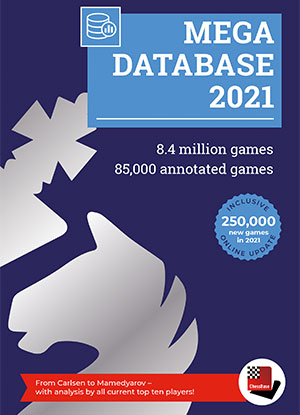
Mega Database 2021
2020
ChessBase
http://www.chessbase.com
E-Mail
info@chessbase.com
Price:€189.90
System
requirements (Minimum): Desktop PC or Notebook, Windows 10, 8.1, 2 GB
RAM, and Fritz 14, 15, 16, 17 or ChessBase 12, 13, 14, 15, 16 and DVD
drive for DVDs / for Downloads no DVD drive required.
The new
MegaDatabase 2021 holds over 400.000 more games than it’s previous
issue 2020,all together you will find over 8.4 million games where a
85000 of them are analysed by the best of the world. Included
is a Mega Update Service 2021 but that only works with ChessBase
15 and 16,but then you get around 5000 new games automatically in the
week!
Further more there is enlarged tournament menu, interesting to mention
is the direct access to all the games of all the World Championships
that ever where played.
But there is more as a direct aces to all Top Tournaments, with Games,
CrossTable and more, plus a player lexicon for download with over
600,000 player names and more than 40,000 player photos but again only
with ChessBase 15 and 16.
Pleasant to read are the tournaments text information’s,and it only
takes seconds to find the games of your next opponent! The repertoire
overview shows you which lines your opponent likes to play and
statistics reveal eventual weaknesses in his or hers repertoire.
Included is a Mega database search booster in the installation files
but again it is only nice for the owners of ChessBase 15 and 16!
A fine example of analyses is: Giri,Anish (2764) - Caruana,Fabiano
(2835) [D55]
Carlsen Inv Prelim chess24.com INT (7.3), 30.04.2020
[Giri,A]
1.d4 f5 The Dutch is a rare guest in top tournament with classical time
control, but just a day before Fabiano got outplayed with it by MVL, so
I wasn't too shocked to see this.
2.Nc3 A side-line I have some experience with. Levon essayed it against
me once in a blitz game too and with Erwin l'Ami (the famous stonewall
expert!) being my trainer, it was really hard to avoid some unpleasant
conversations about the topic of Dutch sidelines anyway. 2...Nf6 3.Bg5
d5 4.e3 e6 5.Nf3 Be7 6.Bd3 0-0 7.0-0 Ne4 8.Bxe7 Qxe7 9.Ne2 Actually so
far we are following both Rychagov-L'Ami and Aronian-Giri. Here we both
went for the more natural c5, but Fabi probably wanted to keep more
tension. After we get c4 c6 though, White clearly has a good version of
the stonewall, having traded the dark squared bishops and with the
bishop being on d3 and not on g2. 9...Nd7 10.c4 c6 11.Rc1 a5 12.a3 Nd6
13.Qc2 Nf6 14.Ne5 I get all the squares and all the fun, but Black is
still rock solid. 14...Bd7 15.cxd5 exd5 16.b4 Rfc8 17.Qc5 I liked this
move. Still, Black is just very solid. 17...axb4 18.axb4 Be8 19.Ra1 Qd8
20.Ng3 g6 21.f3 I didn't like making this move, but on the other hand
the softening of the e3-pawn is rather imaginary, as are the threats of
e3-e4. 21...b6 I was happy to see this weakening, but it also has a
point, if Black is ever to get the c5 push in.
22.Qc3 Qe7 23.Rfe1 Maybe a more useful move could have been played, but
this forces some action, as I now threaten î?¦xa8 and
î?¨xc6. 23...Rxa1 24.Rxa1 Nf7 25.Bf1 Making sure the queen is
keeping in touch with the e3-pawn. [25.Kf2 is a cool suggestion by the
engine, but not to my taste.] 25...Nxe5 26.dxe5 Nd7 27.f4 Nf8 I didn't
mind having this position, which is clearly for two results, but of
course Black may escape if he trades down a lot of material after
getting some c5 and d4 breaks. There is, however, always some hope for
White, with the kingside weakened by 1...f5.
28.Ne2 c5 29.bxc5 bxc5 30.Nd4 [30.Qb3 Bc6 31.Nc3 looked natural and was
strong too, but I suddenly liked the idea of transferring my knight to
f3.] 30...Rb8 31.Nf3 Ne6 32.Ra6!? Applying some pressure along the 6th
rank. Starting with h4! introducing ideas of î?¨g5 and h5 was
even more clever. [32.h4!?] 32...c4 This allows a strong reply
[32...Rb1 is not an issue, as I've got- 33.Qd3!;
32...Bf7 seems the most solid, but after 33.h4 with idea Ng5, White
still puts pressure.] 33.Qd2! [33.Nd4 was also possible, but the move
in the game is more subtle.] 33...Nc5? This blunders a pawn. I was so
happy to see this move and win a pawn that in the next few moves in the
mutual time trouble I played it too simply.
34.Qxd5+ [34.Ra8! would be even more. I saw this motive, but 35.e6! was
too tempting.] 34...Bf7 35.e6! This was the point. The geometry works
for White. 35...Nxe6 I think this move somewhat confused me, I was
mostly trying to make sure that my a6-rook can never be captured.
36.Bxc4 I had calculated that this works for me and gives me a pleasant
4 vs 3, but I missed an even stronger alternative here. [36.Qe5! would
eventually win the pawn too, but not allow Black to simplify as much.]
36...Ng5! I underestimated this strong simplifying move, now Black is
likely to hold a 4 vs 3 with only the major pieces. Still, somehow in
online blitz such small practical advantages have a much higher success
rate than in classical games.
37.Qd3! the right square, keeping both e3 and b1 squares in check.
37...Nxf3+ 38.gxf3 Re8 39.Kg2 e3 pawn is taboo, but in general this
position should be holdable with good defence. 39...Qc5 40.Bxf7+ Kxf7
41.e4 Re7 42.e5 I briefly thought that Fabiano is playing this very
wrong and I will just checkmate him with my major pieces, but I soon
noticed that his king can find safety on h6 and my hopes of winning
this position started to seem less realistic. 42...Rb7 43.Ra2 Kg7
44.Qd8 Rb1 45.Qf6+ Kh6 There is nothing I can do about his king on h6
and there are some counter checks incoming too, so objectively the best
attempt would be to offer a queen trade on f2 and try the rook endgame.
I was still hoping to deliver some lucky mate and it actually worked
out. 46.Kh3 [46.Qh4+ Kg7 47.Qf2 the rook endgame really has to be a
draw, but it not being your usual 4 vs 4 perhaps it was worth a shot.]
46...Qe3 47.Qg5+ Kg7 48.Qf6+ Kh6 49.Qh4+ Kg7 50.Qe7+ Kh6 51.Qh4+ Kg7
52.Rf2! I am sure Fabiano was already counting on the perpetual, as I
dropped to seconds, but the 10 second increment was enough to spot that
I can still protect both my f3- and f4-pawns and give him back the
move. Now pretty much any rook move would hold, for example
î?¦g1 looks very good, when I'd have to just take the
draw, but Fabi made a shocking mistake instead. 52...Qc5?? This lets go
of the f3-pawn and protecting e7-square is quite irrelevant, as I have
got the other check from f6 as well.
53.Qf6+ Kh6 54.Rg2! î?¥c5 was really horrible, as I also had
î?¦d2-d7 ideas, but this one just wins by force quite
trivially. 54...Rb8 Protecting against î?¦xg6+ hxg6
î?¥h8#, but now another mating pattern comes in. [54...Rb7
55.Rg5 Qe7 is the only way to prolong the suffering but after 56.Rxf5
Qxf6 57.Rxf6 two pawns down the rook endgame is dead lost.] 55.Rg5!
Threatening î?¦h5+ î?¤xh5 î?¥g5#
which is quite sweet. Black resigned. 1-0
Conclusion:This is more than important reference material!

Practical Chess Strategy: The Bishop
by Merijn van Delft
2020
http://www.chessbase.com
E-Mail
info@chessbase.com
Price Euro 29.90
Windows 7 or higher
Minimum: Dual Core, 2 GB RAM, DirectX11, graphics card with 256 MB RAM,
DVD-ROM drive, Windows Media Player 9, ChessBase 14/Fritz 16 or
included Reader and internet access for program activation.
Recommended: PC Intel i5 (Quadcore), 4 GB RAM, Windows 10, DirectX11,
graphics card with 512 MB RAM or more, 100% DirectX10-compatible sound
card, Windows Media Player 11, DVD-ROM drive and internet access for
program activation.
MacOSX only available as download! Minimum: MacOS "Yosemite" 10.10
The well
known Dutch chess master explains in a over 6 hour coverage and in two
languages, German and English all strategies of the so powerful
bishops, all explained in 16 highly instructive heavy loaded video
files, where the user will find more than 100 questions to tackle in
video format.
This is indeed perfect material to improve your bishop killing skills!
A fine example of the master himself is: Van Delft,M (2390) - Van
Beek,A (2339) [C67]
Meesterklasse (8), 06.04.2013
[Van Delft]
WORKING WITH A SMALL EDGE
In the following game I played against a very good friend. I decided to
play for a safe little edge and just take it from there. In practice
this approach is not so easy to deal with.
1.e4 e5 2.Nf3 Nc6 3.Bb5 Nf6 4.0-0 Nxe4 5.Re1 [5.d4 Nd6 6.Bxc6 dxc6
7.dxe5 Nf5 8.Qxd8+ Kxd8 leads to the notorious Berlin Endgame.] 5...Nd6
6.Nxe5 Be7 7.Bf1 Nxe5 8.Rxe5 0-0 9.Nc3!? An interesting line, playing
for the bishop pair. [9.d4 is the main line.] 9...Bf6 [9...Ne8 was
played in Iordachescu-Aleksandrov, Nakhchivan 2012] 10.Re1 Nf5
[Exchanging a pair of rooks with 10...Re8 is what the experts started
to play here.] 11.Nd5 c6 12.Nxf6+ Qxf6 Now White has the bishop pair,
but since his development is very modest, Black is not in danger yet.
13.c3 d5 14.Qf3!? I wanted to restrict the black pieces in their
movement. [Previous games saw 14.d4 ] 14...Qg6 15.d4 Nd6 Diagramm
r1b2rk1/pp3ppp/2pn2q1/3p4/3P4/2P2Q2/PP3PPP/R1B1RBK1 w - - 0 0
Question 1
Would you play:
A) 16.¥d3 to bring the remaining pieces into play with gain of time;
B) 16.¥f4 to prevent ¥f5 by attacking the knight;
C) 16.£g3 to offer an exchange of queens and go for the endgame.
16.Qg3! White's chances with the bishop pair are best in the endgame, 5
points. [16.Bf4 is a healthy alternative, 3 points.;
16.Bd3 Bf5 with an exchange of bishops is what White should avoid,
therefore no points.] 16...Qxg3 17.hxg3 Be6 Diagramm
r4rk1/pp3ppp/2pnb3/3p4/3P4/2P3P1/PP3PP1/R1B1RBK1 w - - 0 0
Question 2
Would you play:
A) 18.a4 to gain space on the queenside;
B) 18.f3 to restrict the knight in its movement;
C) 18.¥f4 to develop the bishop with gain of time.
18.f3! Restricting the minor pieces of the opponent is an essential
part of the strategy when playing with the pair of bishops, 5 points.
[18.Bf4 Rad8 19.f3 was played a few months later in Moen-Kvisvik,
Lillehammer 2013 and comes down to the same thing, 4 points.;
18.a4 Nc4 19.b3 Na5 gives Black certain counterplay, therefore no
points.] 18...Rfe8 [Black should consider 18...h5 even when this
creates some new weaknesses.] 19.g4! Another important step in
restricting the opponents minor pieces. 19...Bd7 20.Bf4 Rxe1 21.Rxe1
Re8 Diagramm
4r1k1/pp1b1ppp/2pn4/3p4/3P1BP1/2P2P2/PP4P1/4RBK1 w - - 0 0
Question 3
Would you play:
A) 22.¦a1 to keep one pair of rooks on the board;
B) 22.¦e5 to allow the exchange of rooks, but to change the pawn
structure in the process;
C) 22.¢f2 to allow the exchange of rooks, but activate the king in
the process.
22.Ra1! Having exactly one pair of rooks on the board, limits Black's
counterplay, but keeps enough winning potential. This is a standard
procedure that one can keep in mind for technical positions, 5 points.
[Following 22.Kf2 Rxe1 23.Kxe1 Nc8 Black's defence is a very tough one
to break, 2 points.;
22.Re5 is an interesting idea, but doesn't work in view of 22...f6
therefore no points.] 22...Nc8 23.a4 Gaining space on the queenside,
now that Black's knight is passive. 23...f6 Diagramm
2n1r1k1/pp1b2pp/2p2p2/3p4/P2P1BP1/2P2P2/1P4P1/R4BK1 w - - 0 0
Question 4
Would you play:
A) 24.a5 to gain more space on the queenside;
B) 24.¢f2 to bring the king into play;
C) 24.g5 to open up the position a bit more.
24.Kf2 Generally a good move, but it didn't have priority, therefore no
points. [It was essential to exchange a pair of pawns with 24.g5! to
keep the kingside dynamic, 5 points.;
24.a5 h6 limits White's options, therefore no points.] 24...Be6
[24...h6! was the way to limit White's options.] 25.g5! The right idea
after all. 25...fxg5 26.Bxg5 Bf5 Diagramm
2n1r1k1/pp4pp/2p5/3p1bB1/P2P4/2P2P2/1P3KP1/R4B2 w - - 0 0
Question 5
Would you play:
A) 27.b4 to grab more space on the queenside;
B) 27.¦c1 to prevent the bishop from coming to c2;
C) 27.c4 to open up the position in the centre.
27.Rc1! Preventing any counterplay is a good strategy, 5 points. [27.b4
Nb6 is too hasty and gives the black pieces counterplay on the
queenside, therefore no points.;
27.c4 dxc4 28.Bxc4+ Be6 29.Re1 Kf7 gives Black a pretty square on d5,
therefore no points.] 27...Nd6 28.b3! Further restricting the
opponent's minor pieces. 28...Be6 29.Bf4 Rd8 30.g4! A pretty picture,
having all squares under control. 30...Nc8 31.Bb8!? Keeping the knight
tied to the defence of a7. [31.Bd3 with the idea ¦h1 can be met
by 31...Bf7 with the idea ¥g6.] 31...Bf7 Diagramm
1Bnr2k1/pp3bpp/2p5/3p4/P2P2P1/1PP2P2/5K2/2R2B2 w - - 0 0
Question 6
Would you play:
A) 32.a5 to gain more space on the queenside;
B) 32.¦e1 to take control over the open file;
C) 32.f4 to gain more space on the kingside.
32.f4 Giving Black a good chance to get counterplay, therefore no
points. [32.a5! a6 33.Re1 Re8 and now 34.Be5! was the right way to
prevent all counterplay (5 points), for example 34...Ne7 35.f4 Ng6
36.f5! with total domination. 36...Nxe5 37.dxe5;
32.Re1 Re8 33.Be5 Nb6 followed by ¤d7 is somewhat less accurate,
2 points.] 32...a6 [The pawn sacrifice 32...Nd6! 33.Bxa7 Ne4+ followed
by ¤d2 gives Black serious counterplay. The opposite coloured
bishops will give Black good drawing chances.] 33.Re1 Re8 34.Re5! White
only wants to exchange rooks under his conditions. 34...h5 Diagramm
1Bn1r1k1/1p3bp1/p1p5/3pR2p/P2P1PP1/1PP5/5K2/5B2 w - h6 0 0
A desperate try for counterplay, with time trouble approaching.
[34...Rxe5 35.dxe5] Question 7
Would you play:
A) 35.¦g5 to direct the forces against the weakened g7 square;
B) 35.¥h3 to bring the final piece into play;
C) 35.gxh5 to force matters by taking the pawn.
35.gxh5! While using up most of my remaining time, I basically
calculated until the end, 5 points. [35.Rg5 hxg4 36.Be5 is a good
attacking alternative, 4 points.;
35.Bh3 hxg4 36.Bxg4 is also strong, but less concrete, 3 points.]
35...Rxe5 36.Bxe5! [36.dxe5 and;
36.fxe5 are good alternatives, but the text move works well.] 36...Bxh5
37.Bh3 Ne7 [37...Na7 38.Bb8 and;
37...Nb6 38.a5 Na8 39.Bc8 both lose a piece.] 38.Bd6 Kf7 Diagramm
8/1p2nkp1/p1pB4/3p3b/P2P1P2/1PP4B/5K2/8 w - - 0 0
[38...Ng6 39.Bc8] Question 8
Would you play:
A) 39.a5 to fix the weakness on b7;
B) 39.¢e1 to prevent the bishop from coming to d1;
C) 39.¥xe7to create an entry on c8 for the bishop.
39.a5! The key move, leaving Black helpless, 5 points. [39.Ke1 Bg6
40.Kd2 Bf5! spoiles the white advantage, therefore no points.;
39.Bxe7 Kxe7 40.Bc8 b6 41.Bxa6 is just equal because of 41...Bd1 so no
points.] 39...Bg6 [39...Bd1 40.Bxe7 Kxe7 41.Bc8 Bxb3 42.Bxb7 Bc4
43.Bxc6 is winning because the black pawns are fixed on the wrong
colour. White will put his king on e3 and his bishop on d3.] 40.Bxe7
Kxe7 41.Bc8 Bd3 For a moment I thought that my bishop would be trapped
on b7, but then I saw the winning tactic. 42.Bxb7 Kd7 43.c4! The
winning tactic. 43...Kc7 [43...dxc4 44.Bxa6 wins. 44...cxb3 (44...c3
45.Bxd3) 45.Bxd3] 44.Bxa6 Kb8 45.Ke3 Bf1 46.Kd2 Ka7 47.Bc8 dxc4 48.bxc4
[Here 48.b4! followed by ¢c3 and ¥e6 wins immediately.]
48...Bxc4 49.Kc3 Be2 50.Kb4 Kb8 51.Be6 Kb7 52.Kc5 Bf3 53.d5 Conclusion:
Important components of White's strategy where: 1. Limiting the scope
of the opponent's minor pieces 2. Keeping one pair of rooks on the
board 3. Gaining space 4. Preventing counterplay 5. Opening the
position if possible 1-0
Conclusion: Very instructive but above all enjoyable!
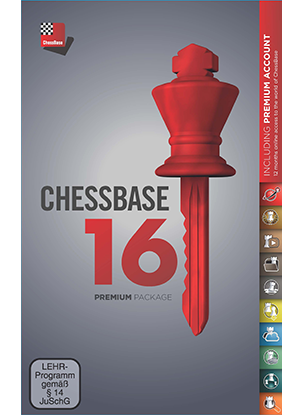
ChessBase 16
2020
http://www.chessbase.com
E-Mail
info@chessbase.com
Price
Euro 119.90
Minimum: Dual-Core, 4
GB RAM, Windows 7, DirectX11 graphics card with 256 MB RAM, DVD-ROM
drive, Windows Media Player 9 and Internet access to activate the
program, ChessBase Cloud and updates. Recommended: PC Intel Core i7,
2.8 GHz, 16 GB RAM, Windows 10, DirectX11 graphics card (or compatible)
with 512 MB RAM or more, 512 GB SSD, Windows Media Player, Adobe Flash
Player (Live coverage), DVD ROM drive, Full HD Monitor and Internet
access to activate the program, ChessBase Cloud and updates.
The new ChessBase 16 comes with the following installation
files,Chessbase 16, 32 bit and 64 bit for Windows 7 and 8,pluss
full installation files {32 and 64 bit} for Windows 10.
The installation went very smoothly and I was surprised how pleasant
and smootly it did run on my PC.
ChessBase 16 did even run on my old mini laptop but please check your
system,the system requirements for ChessBase 16 are quite high,
specially with the 3 D boards: Recommended is: PC Intel Core i7, 2.8
GHz, 16 GB RAM
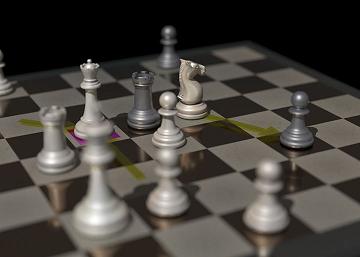
I have the ChessBase 16 program only a few days on my computer but I
can say this,ChessBase 16 is worth every penny you pay for it!
But first of all what is new: Opening surveys for every move with a
single click. With a choice of : Main Variations, Fashion, Side Lines,
Attacking, Gambits, Endgame.
Better overview when playing through deeply analysed games thanks to
dynamic folding of the notation
Urgent news about recently played innovations with direct access to the
database.
Direct database access to tournaments being played live
Preparation for opponents with recognition of their weaknesses taking
into account your own repertoire
Innovations and trends as annotations in Tactical Analysis.
The new search possibilities in ChessBase 16 is more than overwhelming,
open for example your favourite database, and search for weal points in
the repertoire of your opponent.
This all is done in seconds!
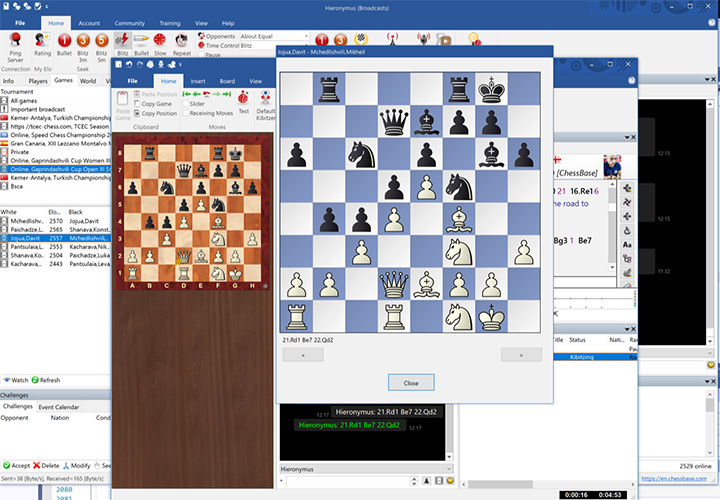
After an update to Megadatabase, overview of important recent
innovations and theoretical trends.
Tags for the management of games.
Search for characteristic tactical positions in an opening variation
plus
Link to the ChessBase Shop and Playchess with modernised chat.
Conclusion: ChessBase 16 is truly
smashing and unbelievable in
price!





